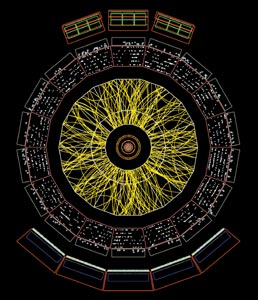Collisions of lead ions at the LHC will take heavy-ion physics into a new high-energy regime.
With the advent of Brookhaven’s RHIC, ultrarelativistic heavy-ion physics has entered a new era of collider experiments. This will continue at CERN with the Large Hadron Collider (LHC) experiments and in particular ALICE, which is dedicated to the study of heavy-ion physics. At the LHC the centre-of-mass energy will increase by a factor of about 30 relative to RHIC energies. In collisions of two lead nuclei at the LHC, the energy density is expected to be up to one order of magnitude higher than that reached at RHIC. As a consequence, strongly interacting matter is predicted to be well within the high-temperature QCD phase, where quarks and gluons are deconfined far above the phase transition point.

The recent results from Brookhaven show that at the energies accessible at RHIC it is possible to probe the dense nuclear matter produced in gold-gold collisions through hadron production at high transverse momentum. The observation of a strong attenuation in the production of high transverse-momentum particles indicates the presence of a very dense initial state through which high-momentum partons have to plough their way into the vacuum.
Heavy-ion collisions at the LHC will not only allow access to much higher energy density, they will also probe this dense matter with a larger variety of hadron production processes at an order of magnitude higher transverse momentum. This puts the LHC in a perfect position for a detailed characterization of the properties of hot and dense QCD matter, as discussed by many theorists working in the field at the recent workshop held at CERN on “Hard probes in heavy-ion collisions at the LHC”. ALICE will gain insight into both the physics of parton densities close to phase space saturation and the collective dynamical evolution of this dense nuclear environment. At LHC energies, the hard processes will contribute significantly to the total cross-section. The attenuation of the hard strongly interacting probes, which will be produced at sufficiently high rates, can be used to study the early stages of the collision. Weakly interacting probes will also become accessible and provide important benchmarks against which signals of the quark-gluon plasma can be searched for. The ratio of the lifetime of the quark-gluon plasma state to the time for thermalization is expected to be significantly larger than at RHIC, so that parton dynamics will dominate the expansion of the fireball and the collective features of the hadronic final state.
The ALICE collaboration of about 1000 physicists and engineers from about 80 institutes in 28 countries around the world has already entered the construction phase of the detector. The main challenge of the experiment is to cope with the highest particle multiplicities anticipated in the lead-lead collisions and measure up to 15,000 particles in the ALICE central detector. The construction of the main components of the detector is advancing well, and the experiment will be ready to take the first data with the start-up of the LHC in 2007.





